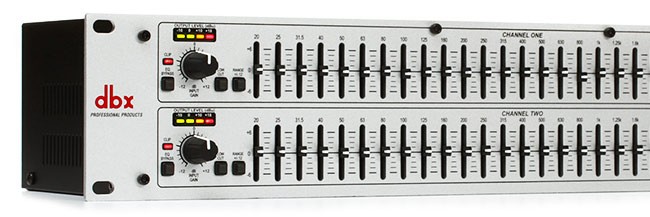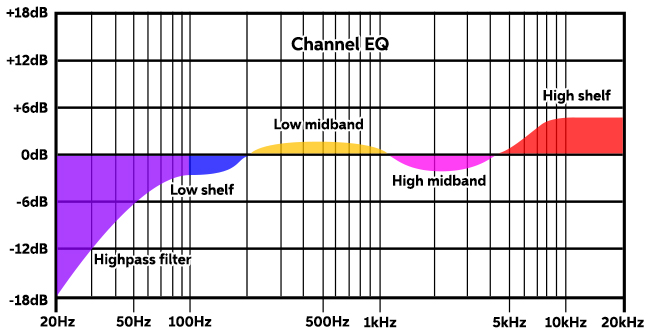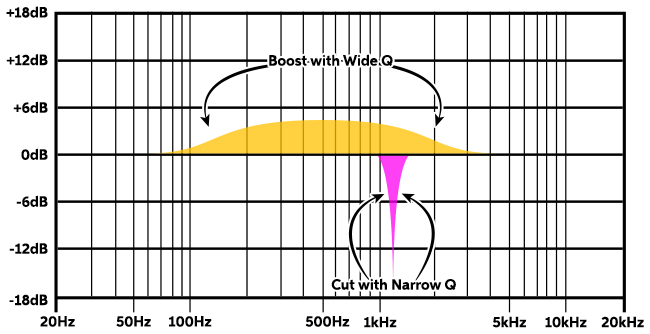Equalization for Live Sound
Used by permission from Sweetwater: Music Instruments and Pro Audio.
What’s an EQ?
Before we dive into the relative merits of parametric channel equalizers and graphic EQs, it’s important to understand a few of the fundamentals that govern all forms of equalization. All equalizers allow you to fix tonal imbalances and bring out desirable characteristics or diminish undesirable parts of your audio by boosting or cutting specific frequency bands. The number of bands you can affect, as well as the precision with which you can affect them, depends entirely on the kind of equalizer you have, and there’s always a trade off between the precision and complexity of an equalizer and how fast and easy it is to use. Generally speaking, equalizers intended to be used for live sound tend to favor efficiency over complexity.
A Few General EQ Tips
Go broad to tune, go narrow to fix
Most equalizers used for live sound mixing will allow you to affect frequencies across a variable frequency range. In general, if you’re trying to tune a sound by emphasizing desirable frequencies or pulling back less important frequencies, then you’ll be better off keeping the bandwidth fairly broad. On the other hand, if you’re trying to notch out hum, tame hiss, or carve out some other unwanted sound, then you’ll preserve your overall sound better by narrowing in on the frequencies you want to remove.
Boosting is more audible (but not better) than cutting
When it comes to fixing problems in your sound, you’ll probably have an easier time if you start by boosting frequencies until you find the problem, and then dropping the gain to cut it out. That’s because it’s easier to notice the frequencies you boost than the ones you cut. However, this phenomenon is a double-edged sword, as it encourages engineers to broadly boost frequencies, which can result in inadvertently boosting problem frequencies and possibly overloading the equalizer’s output. If you find yourself wishing your sound had more highs and lows, you’re more likely to get good results by cutting the mids than boosting the rest.
It’s an EQ, not a magic wand
A talented engineer wielding a top-notch equalizer can add a level of professional polish to individual instruments and complete mixes alike, but there’s a limit to what you can accomplish with even the best EQ. Properly applied, the purpose of an equalizer is to take a good sound and make it better, either by allowing it to sit better in the mix, or by adjusting the overall balance to promote a specific effect. Even the finest equalizer can’t fix bad sound.
Channel Equalizers
What are channel EQs?
All but the smallest live sound mixers include equalizers on each channel, located just after the preamp. The type of EQ can vary dramatically, from simple 2-band shelving EQs to semi-parametric EQs that include adjustable frequency ranges. Many live sound engineers overlook the real power and potential of channel equalizers. While channel EQs are great for fixing minor imbalances, they’re really useful for carving away unwanted frequencies, creating space for your tracks to blend. The better you are at employing channel EQs, the less you’ll need to adjust the faders to get a solid live mix.
Filters
Most channel EQs begin at the preamp stage with a switchable highpass (low-cut) filter that’s typically fixed around 100Hz. This filter lets you cut low-frequency noise, such as microphone handling noise and stage rumble, out of your signal. Aside from bass, kick drums, and other instruments that require the deepest low frequencies, you can apply this filter to most of your tracks and free up a ton of headroom in your mix. More advanced channel EQs may include variable highpass and lowpass filters in their equalizer sections, making it easy to carve out a broader frequency range on individual channels.
Shelving EQs
Most channel EQs (even those found on small, inexpensive mixers) include high- and low-frequency shelving bands that act like the bass and treble knobs in your car’s stereo system. These are great for making broad, sweeping changes. More sophisticated parametric equalizers still include shelving bands but may allow you to adjust the cutoff frequency.
Semi-parametric EQs
The next step up from a simple 2-band shelving EQ is a 3-band EQ that adds a mid-frequency band with a fixed-bandwidth center frequency. The middle-frequency knob acts as a presence control, allowing you to shift channels forward or fade them back in the mix. Full-size live mixing consoles not only add an additional mid-frequency band, but they also allow you to adjust the central frequencies of each of these mid-band EQs, providing you with a far broader range of tuning options.
Parametric EQs
Once you get into the world of digital mixers, studio-style fully parametric EQs become more common. These equalizers not only allow you to adjust the center frequencies of the mid bands, but they also allow you to dial in the bandwidth to make precise alterations to your sound, boosting board frequency ranges for added warmth or notching out an annoying resonance at 1.5kHz. While this surgical precision can be incredibly useful, it’s important not to get mired in minutia that can take up time you simply don’t have in live music production.
Graphic Equalizers
What are graphic EQs?
Graphic equalizers don’t just look and act differently than channel EQs, they serve a totally different purpose. Traditionally, these equalizers occupy a spot in your PA’s equipment rack, between the mixing board and your power amplifiers. Each graphic EQ includes a number of independent frequency bands, and you can use these bands to draw EQ curves and make specific adjustments to your sound. They’re great for tuning your PA to your venue, notching out feedback, or killing hums at specific frequencies. Best of all, the arrangement of the small frequency band sliders across the face of the EQ provides visual (graphic) feedback, so you can see what your equalizer is doing at a glance.
Frequency bands
Where channel EQs typically include one or two mid-band EQ filters, each with fairly broad bandwidth and sweepable center frequencies, each slider on a graphic EQ acts like its own mid-band control, with a proportionately narrow bandwidth and a fixed center frequency. The number of bands varies — 31 bands is standard, but 15-band graphic EQs are also common. Each frequency band covers a fraction of an octave’s worth of frequencies. For example, each slider on a 31-band graphic EQ covers one third of an octave. This allows you to make precise and musical adjustments to your mix, while compensating for acoustic imbalances in your environment.
Non-traditional graphic EQs
While the standard rackmount graphic EQ is in no danger of dying out, there are several non-traditional varieties of graphic EQ that do more or less the same job as their hardware equivalents. It’s fairly common for digital mixing boards to feature DSP graphic equalizers, often including a control mode that allows you to use motorized channel faders as EQ frequency band sliders. Not only do DSP graphic equalizers save you the cost and inconvenience of adding extra rack gear to your rig, but they also provide the added benefit of allowing you to save and recall settings — a real bonus if you frequent the same venues.
PA management systems
Ever since dbx introduced the DriveRack series, PA management systems have become a staple of the live sound world. One of the things these DSP-driven processors provide is automatic EQ control, automatically compensating for your speakers and, with the aid of a special measurement microphone, tuning your system EQ to best accommodate the venue. In many cases, these systems handle a lot of the heavy lifting at the back end of your system, tuning out problem frequencies, eliminating feedback, and generally handling a rack full of gear’s worth of sound-reinforcement tasks. If you don’t want to spend time tweaking graphic EQs, then these systems can save you from serious headaches.








